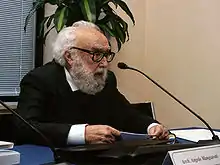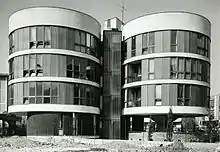Angelo Mangiarotti
Angelo Mangiarotti (26 February 1921 – 2 July 2012) was an Italian architect and industrial designer with a reputation built on "never forgetting the real needs of users". He mainly focused on the industrial process for buildings and design production. The main concept in Mangiarotti's architecture was established through the correct use of matter and technique.
Angelo Mangiarotti | |
|---|---|
 | |
| Born | 26 February 1921 Milan, Italy |
| Died | 2 July 2012[1] (aged 91) |
| Nationality | Italian |
| Occupation | Architect |
Biography

Angelo Mangiarotti was born in Milan, Italy in 1921. He was an architect, urban planner and designer whose designs earned him awards in Italy and abroad.
Angelo Mangiarotti graduated from the Architecture School of Politecnico di Milano in 1948. He moved to the United States in 1953 and started working in Chicago as a visiting professor for the Illinois Institute of Technology. During his time at Illinois Institute of Technology, Mangiarotti met Frank Lloyd Wright, Walter Gropius, Ludwig Mies van der Rohe and Konrad Wachsmann, all of whom were instrumental in his personal and professional growth.
Two years later, Mangiarotti returned to Italy and opened his own architectural firm in Milan with Bruno Morassutti. The partnership was active until 1960.
Angelo Mangiarotti taught at Istituto Superiore di Disegno Industriale of Venice (1963–64), University of Hawai‘i (1970), Ecole Politecnique Fédérale of Losanna (1974), University of Adelaide and South Australian Institute of Technology of Adelaide (1976), Architecture of Palermo (1982), Architecture of Florence (1983) and Architecture of Politecnico di Milano (1989–90).
Major works
The following projects, selected by type, describe the main works of Studio Mangiarotti.
- Early projects
- Exhibition pavilion for Fiera del Mare. Genova, 1963
- Warehouse for ferrous materials. Padova, 1958 (with B. Morassutti and A. Favini)
- Mater Misericordiae church. Baranzate, 1957 (with B. Morassutti)
- Infrastructure
- Projects for "Passante ferroviario" railway system of Milan: Rho-Pero station, 2006; Villapizzone station, 1995; Repubblica and Venezia underground stations, 1992
- Milano Certosa and Milano Rogoredo national railway stations (Ferrovie dello Stato). Milan, 1982
- Industrial and office
- IMM Office and exhibition building. Carrara, 1991
- Snaidero headquarters (office building, exhibition center and public services). Majano del Friuli, 1978
- Precast pre-stressed concrete systems for industrial use
- Facep constructive system. Fiat car distributor in Bussolengo, 1976
- Briona constructive system. 1972
- U70 constructive system. Lema plant in Giussano, 1990; Unifor plant in Turate, 1982; Lema plant in Alzate Brianza, 1969
- FM constructive system. Elmag plant in Lissone, 1964
- Residential
- Residential buildings. Arosio, 1977; Monza, 1972
- Tourist center. Murlongo, 1971
- Residential buildings in Milan. Via Gavirate, 1959; Via Quadronno, 1960 (with B. Morassutti)
- Industrial design
- Design for crystal objects series. 1986–2006
- "Ergonomica" steel collection (cutlery, tray, menagere, bucket, bowls, coffeepot). 1990
- "Chicago" chair made by reinforced fiber glass. 1983
- Silver vases and decanter. 1980 (MoMA collection)
- Marble and stone tables with gravity joint: "Eros", 1971; "Incas", 1978; "Asolo", 1981
- "In-Out" (1968) and "Cub8" (1967) interwall systems
- "Giogali" Murano glass hooks for lighting. 1967
- "Barbados" ashtray. 1964
- "Saffo" and "Lesbo" lamps made by Murano glass. 1966
- "Secticon" watches. La Chaux de Fonds, 1955 (with B. Morassutti)
- Sculpture
- Carrara marble sculptures: "Divenire 2006" in Sydney and Melbourne; "Divenire 2003" at Unifor plant; "Divenire" in Munich
- "Strazio". Carrara marble. Triennale di Milano, 2002
- "Massacro a Sant'Anna". Steel. Sant'Anna di Stazzema, 2000
- "DNA". Aluminium. 1998
- "Datong-simbolo". Carrara marble. Beijing, 1997
- "Equilibrio di una relazione vitale". Bronze. 1995
- "Cono-cielo" marble structure. 1987
- Alabaster sculptures. 1982–86
Exhibitions
Important international exhibitions:
- Tokyo. Gallery-MA. 2004
- Triennale di Milano. 2002
- Carrara. "IL DNA della scultura". 1999
- Tokyo. "Abitare Italia". 1991
- Los Angeles. California Museum of Science and Industry. 1989
- Museum of Science of Oslo and Museum of Trondheim. 1985
- Chicago. Expo Center. 1983
- Paris. Centre Georges Pompidou. 1983
- Milan. "Cinquanta anni di architettura italiana dal 1928 al 1978". Palazzo delle Stelline. 1979
- Florence. "La casa abitata". 1965
Awards
- Marble Architectural Awards. 2007, special mention
- Gold Medal "Apostolo del Design" from Rima Editrice. 2006
- "Honoris Causa" Industrial Design degree. Politecnico di Milano. 2002
- Dr.-Ing. E.h. (honorary doctorate). Technische Universität München. 1998
- Compasso d’oro ADI (career). 1994
- Marble Architectural Awards. 1994
- Design Plus Prize for "Ergonomica" collection. 1991
- Medal and honorary degree. 3rd Mundial Biennal Exhibition of Architecture of Sofia. 1986
- Prix Européen de la Construction Métallique. 1979
- Premio In/Arch. 1962
- Premio Domus Formica. 1956
Bibliography
- Various Authors, "Maestri del Design. Castiglioni, Magistretti, Mangiarotti, Mendini, Sottsass", Bruno Mondadori, 2005
- Toto – Gallery MA, "Angelo Mangiarotti, un percorso-MA-un incontro", Tokyo, 2004
- Beppe Finessi, "su Mangiarotti – architettura, design, scultura", Abitare Segesta Cataloghi, 2002
- Luciano Caramel, "Il DNA della scultura. Angelo Mangiarotti", Internazionale Marmi e Macchine Carrara, 1999
- Francois Burkhardt, "L'aspetto artistico nell'opera di Mangiarotti", Domus, n.807, September 1998, pp. 104–110
- Thomas Herzog (Ed.), "Bausysteme von Angelo Mangiarotti", Verlag Das Beispiel GmbH, Darmstadt, 1998
- Guido Nardi, "Angelo Mangiarotti", Maggioli Editore, Rimini, 1997
- Enrico D. Bona, "Mangiarotti", Sagep, Genova, 1988
- Angelo Mangiarotti, M.Luchi, L.Bonesio, L.Magnani, "In nome dell'architettura", Jaca Book, Milano, 1987
- Enrico D. Bona, "Angelo Mangiarotti: il processo del costruire", Electa, Milano, 1980
- Ichiro Kawahara, "Angelo Mangiarotti 1955–1964", Seidoh-Sya Publishing Co., Tokyo, 1964
References
- "L'ultimo saluto a Angelo Mangiarotti | Anteprime dal mondo" (in Italian). Blog.atcasa.corriere.it. 17 September 2009. Retrieved 27 August 2012.

